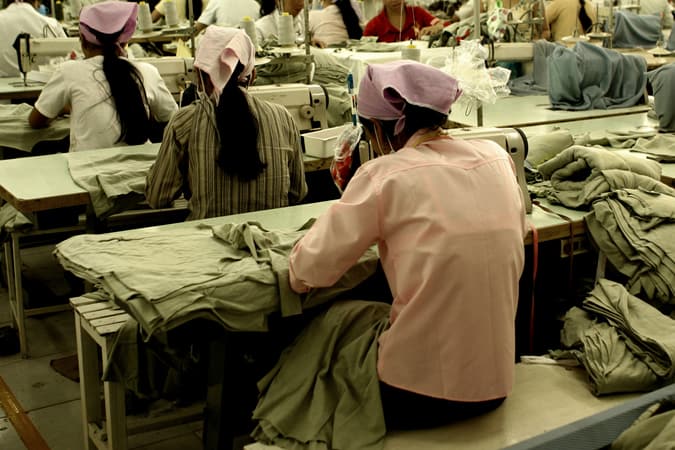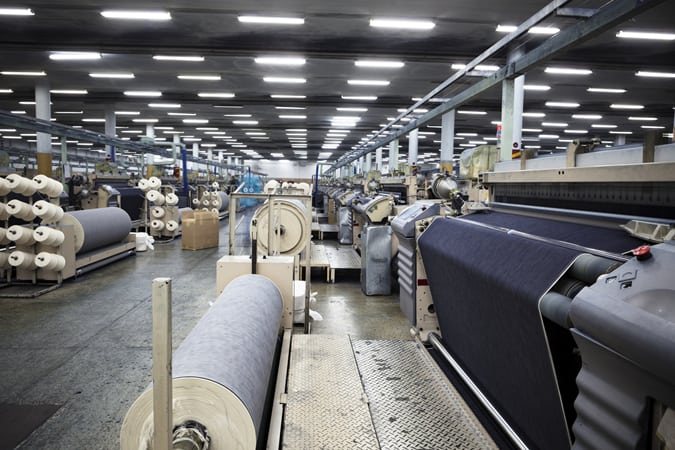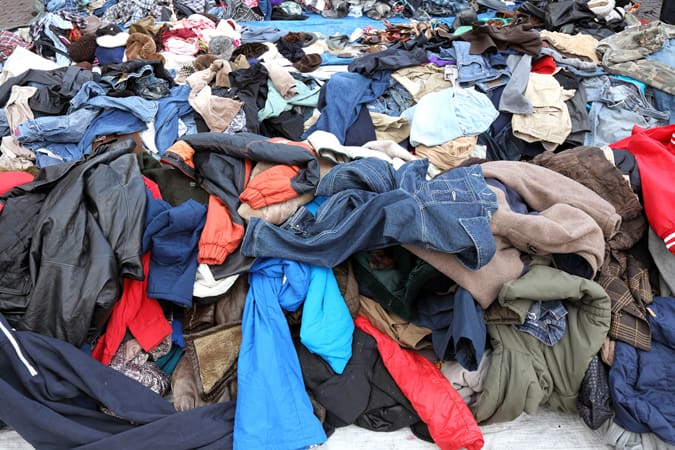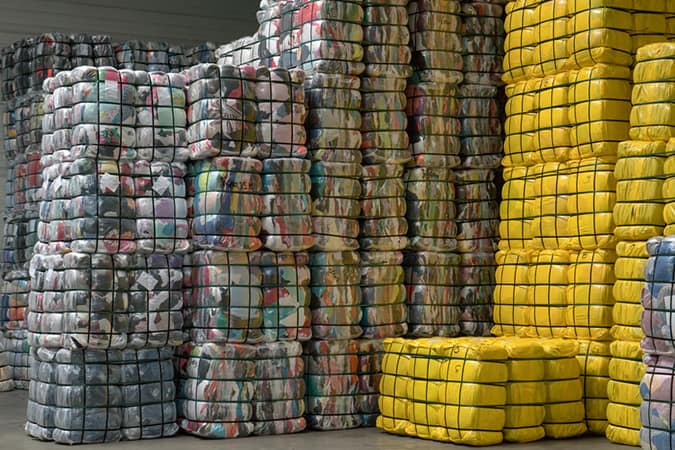

What is fashion fashion? For the Oxford English Dictionary, it’s “inexpensive clothing produced rapidly by mass-market retailers in response to the latest trends”. To many others, it means some of the worst excesses of our rampant, rapacious consumer culture. Pesticides. Toxic chemicals. Air and water pollution. Plastic microfibres. Exploited workers. Child labour. All so that we can buy unfathomably cheap products and throw them away as soon as they go out of style or we get bored, if they don’t fall apart before then.
But what does fast fashion really signify? Is it as catastrophic for people and planet as it sounds? And will the current, dizzyingly swift system of oversupply stimulating endless demand soon come off the rails? FashionBeans unpicks the threads with the help of some world-renowned experts.
Just how fast is fast fashion?
“When I first started in the industry, we used to work on two seasons: spring/summer and autumn/winter,” says Dr Mark Sumner, a lecturer on sustainability, fashion and retail at the University of Leeds who gave evidence to the UK government’s Environmental Audit Committee on the rag trade’s impact. “Now you have four seasons and each of those is broken down into phases.”
New products hit stores more frequently, and the design process of those products has also been compressed: online retailer Boohoo can dream up a pair of joggers and have them on sale in as little as two weeks. True, the raw materials – the cotton or polyester, the yarns they’re spun into, the fabrics they’re woven or knitted into – will have already been produced, but the final design and shipping is fine-tuned global commerce at its most efficient.
A fast turnaround doesn’t necessarily mean bad practices however, nor slow good. “Most of the sustainability of the product is locked in at the raw materials and processing stage,” says Dr Sumner. So if a brand hasn’t committed to using, say, sustainable cotton, speed is irrelevant, the same as if it doesn’t support ethical labour (more on that later).
“Fast isn’t all it’s cracked up to be,” says Orsola de Castro, co-founder of Fashion Revolution, a global advocacy group calling for greater transparency, sustainability and ethics in the industry. She points out that huge volumes of average clothing and a capsule collection by a new designer can reach consumers with the same speed: “Fast isn’t the problem, vast is – vast amounts of product leading to vast amounts of waste.”
Why is fast fashion so cheap?
Principally, economies of scale. The fabric can be as much as 50-60 per cent of the cost of the product. And as well as discounts for buying in bulk, some fabrics are more economical than others. “They might be lighter weight, they may be made using cheaper materials, they may have come through a route that’s very simplistic, they may have no particular special finishes applied to them, or functions,” says Dr Sumner.
Another factor that enables a brand like Primark to sell clothes for cheaper than a sandwich is that it doesn’t fork out on marketing or e-tail, saving on shipping and returns that would otherwise eat into its margins.
A less palatable explanation comes from Fashion Revolution’s de Castro. “All fashion supply chain workers – cotton farmers, spinners, jibbers, weavers and garment workers – aren’t paid a fair and living wage,” she says.
“Taking advantage of lower prices in markets in developing countries”, to use the mealy mouthed euphemism from the Wikipedia page on fast fashion, is commonplace. If you don’t see the point of forking out more for ethical clothing, watch some of the two-minute films about Cambodian garment workers posted on YouTube by the charity Traid, which raises money from reusing and reselling clothes to benefit their makers.
Paid £3.37 a day, they’re forced to rub themselves with coins to draw blood to the surface and release heat in order to stop themselves fainting in sweatshop factories where temperatures regularly exceed 40 degrees, among other indignities. It’s grimly symbolic.
[embedded content]
Abhorrent horror stories such as these abound, to the industry’s shame. But newspaper articles about a brand’s poorly paid makers have to be viewed in the cultural context, says Dr Sumner: what might not sound like much to us here may be the equivalent of more there, and legal if not moral.
And clothes made here in Britain – surprisingly on the rise thanks to fast fashion, because it reduces time in transit – doesn’t guarantee probity: garment workers in “dark factories” in Leicester are routinely paid £3.50 an hour – way below the minimum wage of £7.83.

What’s the mark-up on a fast fashion product?
It’s hard to say as, understandably, brands and retailers guard this information carefully. Private White VC, which openly declares its mark-up of two to three times cost price, partly to contrast it with the typical luxury brand’s five to seven times, is one of the radically transparent exceptions. Also, the margin varies dramatically from product to product.
Generally speaking though (and it is very generally), high-volume brands will make lower margins on each product, while low-volume brands will make higher margins. “I do get the impression from conversations with various brands that those at the more fast-fashion end are making less margin per garment than those brands that are more designer or luxury, where the margin can be double digits, if not more,” says Dr Sumner. A £4 T-shirt that’s been shipped from Bangladesh can only have been marked up so far.
In some cases, products don’t make any margin at all: they’re loss-leaders, made to test something out or to lure customers in the hope that they’ll also buy other more profitable products – a tactic common in other areas of retail, particularly supermarkets. Boohoo has likened its products to food that goes “stale” if it sits around too long.

How long will a fast fashion garment last?
With costs cut on materials and labour, you’d think that a fast fashion garment’s lifespan would be as brief as its production. But as evidence submitted by Dr Sumner to the Environment Audit Committee proves, affordable jeans from a fast fashion brand can be twice as durable as a designer pair costing ten times as much.
“What we found was there was no correlation at all between the price that a customer pays and the product quality and durability,” says Dr Sumner, who also showed that a T-shirt by an online fast fashion brand was superior to a designer alternative – which in fact was the worst-performing product across all the tests conducted. To reiterate, because it bears repeating, price has no correlation to quality, durability or sustainability.
Dr Sumner’s suggestion therefore is to check a brand’s website and see what initiatives they’ve signed up to – for example, the Sustainable Clothing Action Plan, a voluntary agreement to reduce waste created in a garment’s production and at the end of its life. “Some fast fashion brands are doing some extraordinary stuff in terms of sustainability,” he says. “Whereas some luxury brands don’t appear to be doing very much at all.”
Fashion Revolution’s Transparency Index reviews and ranks 150 of the biggest brands and retailers according to how open they are about their practices. None scores higher than 60 per cent, and the pitifully inadequate average is 21. But those with least to hide include Adidas, Reebok, Puma, H&M, Esprit, Banana Republic, Gap and Marks & Spencer.

Is fast fashion disposable?
Not always: as we’ve seen, fast fashion garments can be better made and more durable than slow ones. (They can, of course, also be cheap crap.) But the low cost and quick turnaround of fast fashion does encourage binning and buying afresh. Three in five garments end up in landfill – 235m of them in 2017 – or incinerators within a year.
“The value of clothing has decreased,” says Dr Sumner, who has also researched why people throw away or donate clothes, the vast majority of which is “perfectly functional product”. The reason is rarely because the garment is worn out – although Dr Sumner says that quality has declined across the board – but because its shine has worn off: “Value is not just pounds and pence, but also the emotional connection we have with clothing.”
Again, this mentality isn’t restricted to fast fashion but is a “much broader cultural thing”: it’s often easier, cheaper and more appealing to buy a new washing machine than repair your old one. “I’m sure if you go into your wardrobe, you’ll probably find fast fashion stuff that you bought five years ago, but you’ve got some emotional connection to it, which means that you keep it,” says Dr Sumner. “Equally, if you fall out of love with a product, then you’ll donate it or it will sit at the back of your wardrobe – whether it’s slow or not.”
Ultimately, what really makes fashion fast or slow is when the fickle or faithful consumer decides to dispose of it. “A garment will last as long as you care for it,” says de Castro.

Is fast fashion killing the planet?
“No, fast fashion is not killing the planet,” says de Castro. “We are killing the planet.” Clearly, the 93bn tonnes of water guzzled and 1.3bn tonnes of carbon dioxide emitted in worldwide textile production each year is not helping. But fashion, fast and slow, is only the fourth largest polluter globally, behind housing, transport and food, if by far the least essential. That’s not to say that it doesn’t need to change dramatically and urgently – just that it’s by no means the only planet-killing culprit: “Fashion, like all industries, has to take stock of its impact and practices, and its responsibility in shaping a better future.”
“To give balance to all this, fast fashion has done some really, really positive things for individuals,” says Dr Sumner. “It’s allowed people to access fashion, to create their self-identity. It’s democratised the industry. The downside is this consumption culture.”

What’s the future of fast fashion?
“Feasibly, it could go even faster,” says Dr Sumner, who argues that wouldn’t necessarily be catastrophic if clothes were designed to be more easily biodegradable or recyclable: “That is potentially a better position than we’re in now.” But even with his green-tinted glasses on, he concedes that a lot would have to line up for that to happen.
Renting clothes may also help to satisfy the compulsion to not be seen more than once in the same outfit without the wastefulness. But that will only do so much unless we change the culture of consumption that saw 100bn garments produced in 2015 on a planet of only 7bn inhabitants. Otherwise, climate change, and the increasing scarcity of water and energy, will do it for us. (Although a Swedish power station is now burning discarded H&M clothing, but that’s hardly sustainable or environmentally friendly.)
“Clothing will become far more expensive, and we will have to reduce the amount that we produce,” says Dr Sumner. “Unfortunately, if we get to that stage, it’s too late.”
Be the first to comment